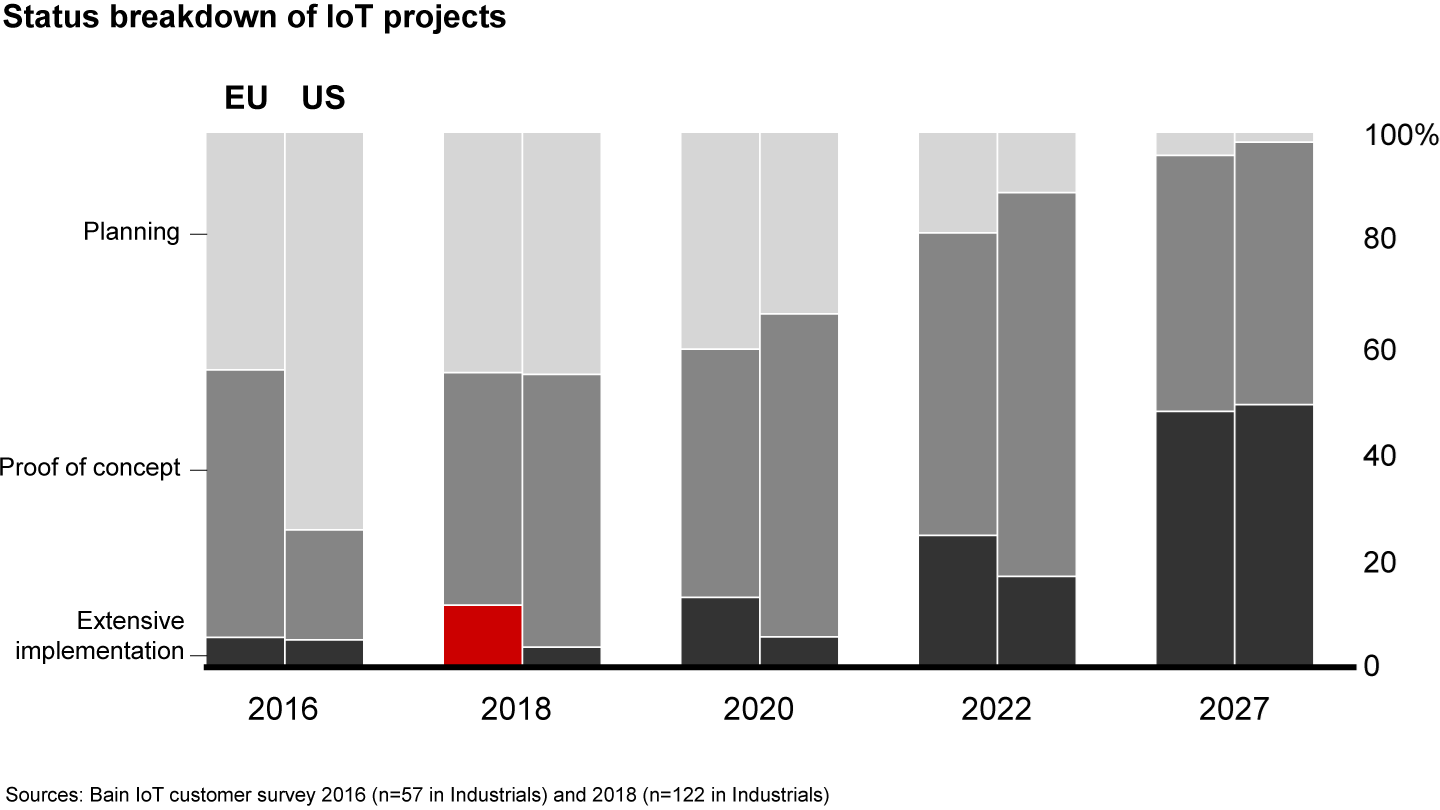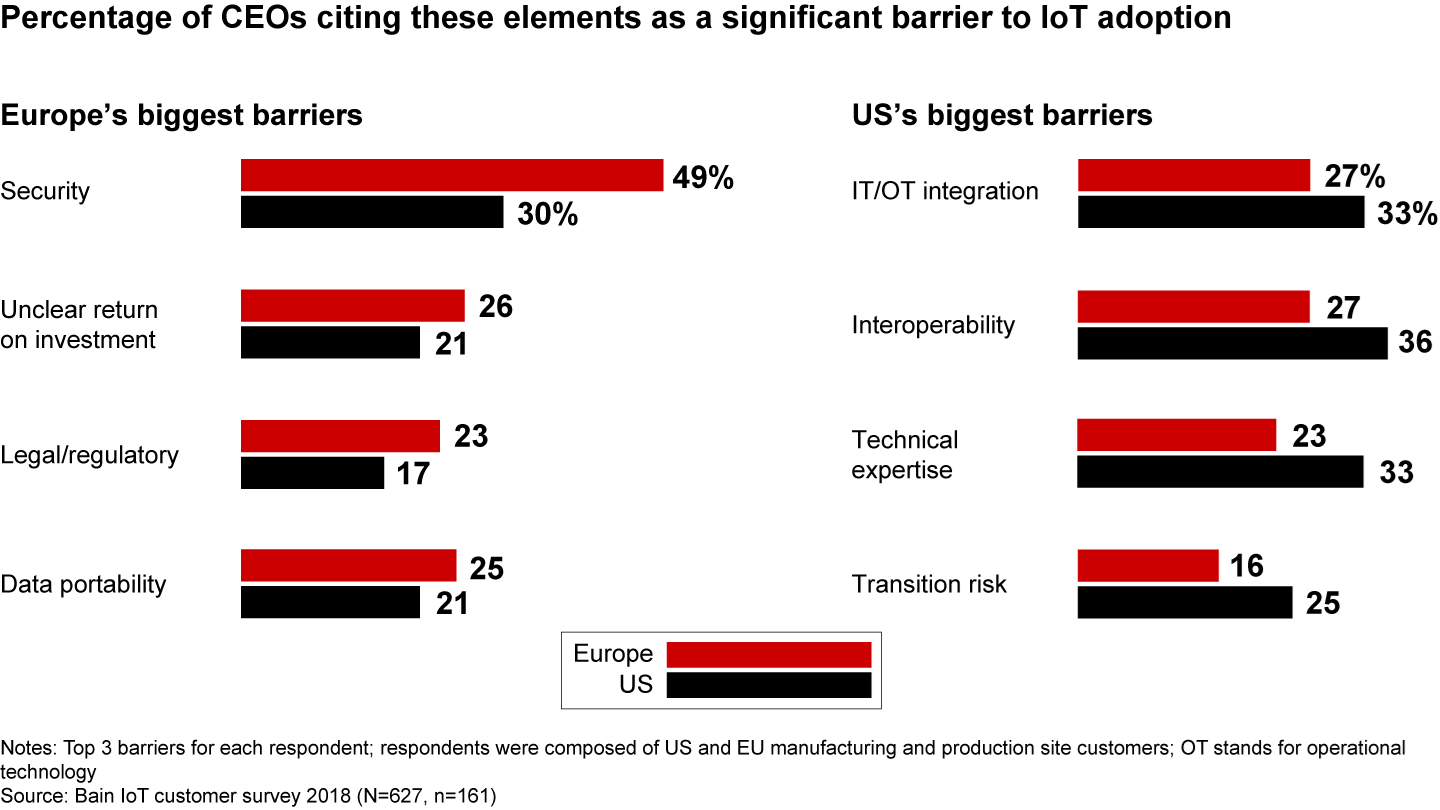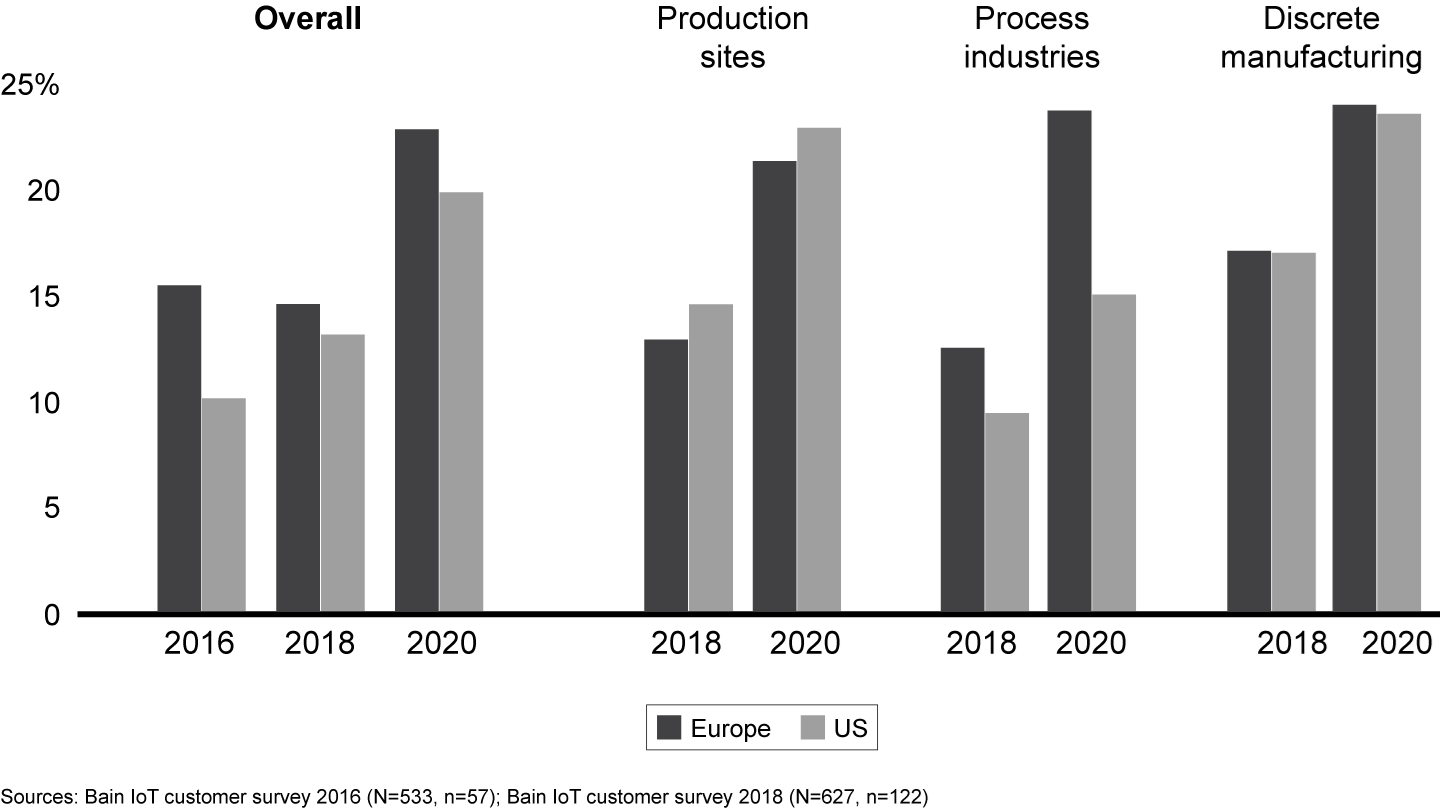Brief

Executive Summary
- European companies have invested in the Internet of Things at higher levels than their competitors in the US.
- Europe’s early lead, particularly in the industrial Internet of Things, has helped them move to scale faster, with three times more extensive implementations than in the US.
- Companies in the US are still struggling with implementation issues that the Europeans have mostly worked through, but executives in both regions are most concerned about cybersecurity.
When we surveyed executives in Europe and the US two years ago about their plans for deploying industrial use cases for the Internet of Things (IoT), we found European companies ahead in the deployment of industrial IoT solutions. More European executives (27%) planned to deploy IoT solutions compared with their colleagues in the US (18%). We also found companies in some European industries devoting more of their IT budgets to the Internet of Things, particularly automotive, buildings and industrial.
The results of our most recent survey in 2018 show Europeans pressing their IoT advantage. While the long-term ambitions of executives in both regions appear closely matched, European companies are further along in implementation than their US counterparts, particularly in the industrial sector (see Figure 1). Europeans also appear further along in cracking the code to unlock value from IoT solutions.
European manufacturing and production sites implement more industrial IoT solutions than their US peers


Europe’s stronger engagement in proofs of concept (POCs) and higher investment levels in 2016 helped them move to scale faster, with three times more extensive implementations in 2018. US companies are ramping up investing in POCs and plan to invest primarily in these through 2022.
Europeans also remain more concerned about security. US executives share these concerns, but they also struggle with implementation—an indicator that they have not climbed as high on the learning curve as their European competitors.
Looking ahead, the greatest challenge for Europe’s IoT providers is to become leaders in cybersecurity, to meet the needs of their commercial and industrial customers that remain wary due to their security concerns. European companies must also continue to address the complex privacy and regulatory environment of the EU. Mastering these challenges could position Europeans as global leaders with a competitive advantage over their peers from other regions.
Adoption barriers
In Europe, security concerns dwarf other barriers to adoption (see Figure 2). Industrial customers in the US say they are more concerned with issues that would bring IoT solutions into the mainstream of their businesses—namely, integration with other operating technology, interoperability, technical expertise and transition risk. US executives were much more likely to cite these concerns in our 2018 survey than in 2016. These challenges limit the degree to which companies scale their POCs into daily, operational implementations of IoT technology.
Industrial customers in Europe regard security as the biggest barrier, while their peers in the US struggle more with integration and interoperability


Europeans’ more extensive experience with implementing IoT solutions contributes to their increased awareness of cybersecurity risks. Bain research across industries finds that executives at companies with greater cybersecurity sophistication see more risks than those at companies with less sophisticated cybersecurity capabilities (see the Bain Brief “Cybersecurity Is the Key to Unlocking Demand in the Internet of Things”).
Return on investment is less of a concern today than it was two years ago, since the POCs have validated the value that the Internet of Things adds. The implementations were more complicated than anticipated, however, so concerns about implementation and interoperability have risen slightly.
Investment plans
Europe’s lead in implementation is a direct result of commercial and industrial customers allotting a higher percentage of their technology spending to IoT deployments compared with their US counterparts (see Figure 3). Funding levels have remained roughly constant in Europe over the past two years, reflecting the reality that it can take longer than originally expected to overcome implementation barriers, especially security (see the Bain Brief “Unlocking Opportunities in the Internet of Things” for more on customers’ tempered expectations). Discrete manufacturing represents the greatest percentage of allocation in Europe and the US, with process industries following closely behind.
European industrial customers allot more of their IT budgets to the Internet of Things and analytics, and they plan to continue doing so


Looking ahead at the investment plans of industrial customers, Europeans are poised to hold a narrowing lead, with more than twice as many extensive implementations in 2020 as their US counterparts. Looking almost 10 years ahead—an imprecise endeavor, but one that can shed light on aspirations—the investment plans of executives in both regions could result in a more competitive position, with the US expecting to see similar levels of POCs and implementations as the Europeans.
The key challenge for both regions remains addressing cybersecurity concerns, not only by the vendors but also for customers, who will need to ramp up their security investments significantly to benefit fully from IoT technologies. Bain research finds that customers would buy more IoT devices, and pay more for them (about 22% more on average), if their security concerns were addressed. Becoming a leader in security remains a powerful opportunity for European IoT champions.
IoT providers in both regions could also speed their progress in reducing barriers by focusing their investments on fewer industries, which would allow them to develop greater expertise and deliver more comprehensive end-to-end solutions to their customers. The learning curve effects from POCs will allow vendors to overcome the implementation concerns of their customers by offering more packaged solutions that can scale more easily.
Partnerships with industrial vendors are especially important, as they provide specific domain knowledge and system integration capabilities. Without these partnerships, IoT vendors may continue to struggle to sell solutions that integrate smoothly with customers’ businesses and processes.
Leading industrial companies are moving quickly past the proof stage, and now, it’s all about scaling. Over the next two to three years, clear winners will emerge, as the benefits of early investment kick in and their POCs scale up to operational levels. Companies that have put off investment will lose ground to competitors that are learning how to derive value from the Internet of Things and becoming more data-driven every day—skills that will form the basis of competition in a world of extreme automation and artificial intelligence.
Ann Bosche, Michael Schallehn, Christopher Schorling and Oliver Straehle are partners with Bain & Company in San Francisco, Silicon Valley, Frankfurt and Zürich, respectively. Ann, Michael and Christopher work with Bain’s Global Technology practice, and Oliver leads Bain’s Advanced Manufacturing & Services practice in Europe, the Middle East and Africa.